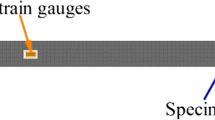Summary
This paper deals with various applications of newly developed photoelastic gages for strain measurements on metallic and nonmetallic structural members. Simplicity of application and direct indication of the magnitude and the directions of the principal strains in biaxial-stress fields are some of the merits of photoelastic strain gages.
Similar content being viewed by others
References
Oppel, G. U., “Photoelastic Strain Gages,” Experimental Mechanics, 65–73 (March 1961).
Mesmer, G., “Spannungsoptik,”Julius Springer Verlag, Berlin (1939).
Durelli, A. J., and Murray, W. M., “Stress Distribution around a Circular Discontinuity in any Two-Dimensional System of Combined Stress,” Proceedings 14th Eastern Photoelastic Conference (Dec. 1941).
Oppel, G., “Photoelastic Investigation of Three-Dimensional Stress and Strain Conditions,” National Adv. Committee Aeronautics, Techn. Memo 824 (1937).
Norris, C. B., “The Application of Mohr's Stress and Strain Circle to Wood and Plywood,” Forest Product Lab. Madison, Wis., Report 1317 (Feb. 1943).
Additional information
Joseph Schwaighofer was associated with Department of Engineering Mechanics, The Pennsylvania State University, University Park, Pa., at time that paper was prepared.
Rights and permissions
About this article
Cite this article
Schwaighofer, J. Applications of photoelastic strain gages. Experimental Mechanics 1, 198–202 (1961). https://doi.org/10.1007/BF02322960
Issue Date:
DOI: https://doi.org/10.1007/BF02322960




